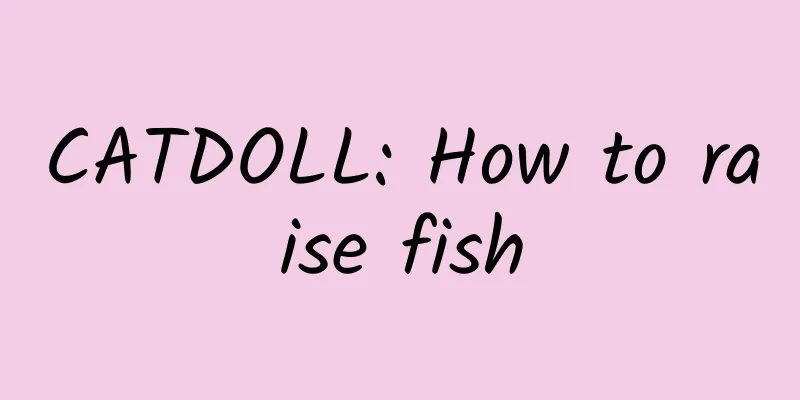CATDOLL : CATDOLL: How to raise fish

|
You can just keep it in a fish tank and prepare an oxygen pump and a filter tank. 1. Use the correct feeding method and feed the fish 2%-9% of their body weight. 2. Compared with high-density feeding, low-density feeding gives fish a larger living space and is more conducive to their growth. 3. Water is the basic condition for fish farming, and it can also be said that water is the life of fish. The glass tank should be placed near a window where it is well ventilated and has sunlight. Pay attention to the stocking density and arrange it reasonably according to the size of the container. It is better to keep fewer fish than more. Because the indoor air is not well circulated, if you keep too many fish, the water will become turbid, which may cause the goldfish to die due to lack of oxygen. If you have an air pump, you can keep more fish. If you find that the goldfish are floating, you need to turn on the air pump to add oxygen, especially at night. Live fish worms are the most ideal bait for fish farming. The water quality is not easy to deteriorate. Dried fish worms and artificial synthetic pellet feed can also be used. Live fish worms are now available on the market, but it is troublesome to buy them every day. For the dried fish worms sold on the market, choose fresh ones with loose particles to feed the fish. Do not buy old and moldy dried fish worms to feed the fish. It is better to use complete feed with complete nutritional ingredients for artificial pellet feed, which is available on the market. In order to keep the water pure, the amount of feed should be strictly timed and quantitative. Usually, it is advisable to feed once or twice a day. Each amount of feed should be eaten within half an hour. Do not feed too much. There are two harms of feeding too much: first, the fish will be full, the metabolism level will increase, and the oxygen consumption will increase, which may cause the goldfish to die of suffocation due to lack of oxygen; second, the leftover feed will easily rot and ferment, causing the water quality to deteriorate, which will also cause lack of oxygen. In fact, goldfish are relatively resistant to hunger, and there will be no problem if they are not fed for a week or two. It is very important to keep the water pure when raising goldfish. You should often use a latex tube to suck out the accumulated residue, the feces, leftover bait and turbid water at the bottom of the glass tank, and then slowly add new water that has been placed for a day. If the water plants float up or the rockery is knocked down during the operation, you should restore it to its original state in time. The longer you keep fish, the more sediment will accumulate. Even if you clean it every day, you can't remove it all. If the sediment increases and affects the clarity of the glass tank, you must completely change the water and clean the glass tank to keep the water pure, easy to watch, and maintain a good living environment for goldfish. The rectangular glass tanks generally used are small in size, so you cannot keep too many fish. It is better to keep fewer rather than more. For example, in a container that is 40 cm long, 25 cm wide and 30 cm high, you can keep 6 to 8 goldfish that are 5 cm to 7 cm long. Adult fish that are more than 8 cm long should not be kept in small glass tanks, but in luxurious large glass tanks or ceramic tanks, and equipped with a small oxygenator to prevent hypoxia. The above stocking density is only a reference. It also depends on the water temperature, the size of the fish and the quality of the water. It cannot be determined mechanically. Generally speaking, if the fish is large, you should keep fewer fish; you can keep more fish in winter and less fish in summer; you can keep more fish when the water temperature is low and less fish when the water temperature is high. Selecting Goldfish Choose fish with strong bodies and bright colors When choosing any kind of goldfish, you should choose one with a broad and strong body, complete chest, abdomen and tail fins, and a wide and open tail. For fish without dorsal fins, choose those with smooth backs and no broken dorsal fins or tubercles. As for the color of the fish, choose red ones with delicate red, white ones with pure white, blue ones with deep blue, black ones with dark black, and those with harmonious colors and delicate patterns. Only those with blue can be called five-colored. Some fish have a half-red and half-black body or a red body with black edges of the fins. They look beautiful now, but in fact they will soon become completely red. You should be prepared. When selecting fish, those that are unique in characteristics, body shape or color should be selected as an exception and observed and cultivated. Choose healthy fish Generally speaking, fish that swim actively, get along well with each other, have a plump body, have open and paddling pectoral and pelvic fins, have no white spots or white fluffy mucus on their bodies, have no bloodshot or ulcers on their tails and scales, rarely float on the water surface, lie on their sides, stand upside down, or sink to the bottom, and have black and thick stools are healthy fish. Fish that are looking for food can be purchased boldly. Choose fish with obvious characteristics All kinds of fish have the characteristics of their species: for example, when choosing species such as Shouxingtou, Lionhead, Crane's Red, and Goose's Red, they are all famous for having tumors on their heads, so we should choose the ones with the most developed and wide tumors on the gill cover. In addition, the fish with red tumors such as Crane's Red and Goose's Red are the best with square red tops (the top of the head is darker when young). When choosing pearl scale fish, we should pay attention to the fact that there are two types of tails, large and small, and the large tail is better. But no matter whether it is a large or small tail, we should choose a small pointed head, thick and intact pearl scales, and arrange them neatly to the back, but the scales cannot stand upright, otherwise most of them are scale standing diseases. The abdomen is swollen and round, and the tail is smooth. This feature is purebred. Water bubble or dragon eye is named after the characteristics of the eyes, so we should choose water bubbles that are round, large and symmetrical, and the bubble is soft and transparent. When choosing dragon eyes, we should choose those with large and protruding eye discs like chess pieces. It has become an indisputable experience that raising fish starts with raising water. How to "raise" a tank of clear, non-toxic water at home is extremely important. Raising fish at home is different from raising fish in a fish farm. The water space is small, and the water quality must be clear and transparent for viewing goldfish. Raising fish in a fish farm is to make goldfish grow quickly. There are professional fish workers to monitor the water quality at all times. The water body is large and suitable for goldfish to grow. Raising goldfish at home has its own advantages. For example, water temperature. Since family fish are generally raised indoors, they are not affected by wind and rain. In addition, since the amount of water in family fish is small, it is convenient to observe water quality and control drugs. The water quality of home goldfish is mainly related to the following five factors. 1. Filtration system: Due to the high density of fish farming in households, it is difficult to remove impurities and wastes in the water simply by relying on the water's own decomposition. Establishing a good filtration system can effectively maintain water quality. A good filtration system can integrate chemical, biological, physical and other filtration methods. Chemical filtration relies on special drugs to condense tiny suspended impurities in the water so that they are precipitated or physically filtered out. Biological filtration is the decomposition of waste in the water by beneficial biological flora in the water, decomposing harmful substances into harmless substances. Physical filtration is the adsorption and filtration of impurity particles through the tiny pores of the filter material. According to the characteristics of goldfish and the conditions of household fish farming, the following methods can be used to establish a filtration system. According to the size of the aquarium, configure an external filter, which can be a top-mounted filter or a filter barrel. The water flow rate can be found in the instructions of the water pump. Generally speaking, it is appropriate to circulate the water body about 7 times per hour. For example, the volume of an aquarium with a length of 80, a width of 40, and a height of 40 is 128 liters, and the flow rate of the filter water pump should be selected at 900 liters/hour. For larger aquariums, in order to prevent the water flow from being too strong, it is recommended to install a built-in filter at the water inlet and add a bend at the water outlet to reduce the impact of the water flow on the goldfish. Place biochemical sponges and activated carbon in the filter box (bucket) and replace them according to the degree of water pollution. However, too frequent replacement is not conducive to the establishment of beneficial biological flora. Generally, it can be replaced once a month. 2 Biological decomposition: In the natural environment, a large number of beneficial bacteria colonize the places where rivers flow through. They can decompose the metabolites and foreign pollutants produced by aquatic organisms. To keep the water clean and harmless. Establishing beneficial bacteria in the aquarium can maintain water quality for a long time without frequent water changes. Adding nitrifying bacteria to the aquarium is a shortcut to establish a biological decomposition system. Nitrifying bacteria sold on the market are mainly divided into two categories, active nitrifying bacteria and artificial nitrifying bacteria. Active nitrifying bacteria use living bacteria as the main substance. Artificial nitrifying bacteria use substances that promote the growth of existing nitrifying bacteria in the water. Active nitrifying bacteria have a short onset time, usually within 2-5 days depending on the water temperature, and the effect is most obvious when the water temperature is 25-30 degrees. However, the shelf life is short, usually not more than 12 months. Artificial nitrifying bacteria have a long shelf life because they do not contain active strains, usually about 2 years. But the onset time is longer. Before establishing a biological system, it can be used in combination with a water clarifier. 3. Fish density: No matter how big the aquarium is, the number of goldfish that can be raised is limited. Goldfish are lively and active, and can eat and poop. The water quality is harder to maintain than that of small tropical fish. Reasonable breeding density is very important for beginners. Usually, each one-year-old goldfish takes up 10 liters of water. That is, the volume of an aquarium that is 80 cm long, 40 cm wide, and 40 cm high is 128 liters, which can raise 12 one-year-old fish. It will be difficult to maintain water quality for a long time if the density is higher. In addition, different goldfish species have different requirements for breeding density. The breeding density of precious species such as pearls, butterfly tails, and bubbles is smaller. 4. Feed selection: The feed given to goldfish also has a great impact on maintaining water quality. Goldfish are omnivorous animals. The food range is very wide. Mainly including: Daphnia, nematodes, bloodworms, granular feed, powdered feed, flake feed, etc. Live Daphnia is the best choice. Not only during feeding, Daphnia can absorb organic suspended matter in the water. And the metabolites produced by goldfish are not easy to disperse. Nematodes, bloodworms, powdered feeds or because they will be attached to the sand bed or suspended in the water, it is not conducive to the cleanliness of water quality. High-quality artificial synthetic feeds will contain yeast, which can quickly decompose the metabolites of goldfish and is beneficial to maintaining water quality. Inferior synthetic feeds are not only without nutrition, but also contain artificial pigments, which will discolor the water. In addition, it is best not to use edible fish feed, such as crucian carp feed to feed goldfish, which will also spoil the water quality. During the feeding process, the filtration system should be turned off to avoid being sucked into the filter box, which will not only cause waste, but also mold in the filter box to produce toxic substances. 5. Fish breeding environment: Lighting, scenery, etc. also have a certain relationship with maintaining the water quality in the aquarium. Too strong light will cause a large number of algae to grow in the water. Properly covering with curtains and regular cleaning will effectively control it. Placing a sand bed at the bottom of the aquarium will also help clean the water. It can not only absorb impurities, but also provide a breeding ground for nitrifying bacteria. The general thickness is about 4 cm and the particles are about 4 mm. If the sand bed is too thin, it will not have an adsorption effect; if the sand bed is too thick, the bottom sand bed will lack oxygen and cause biological corruption. If the particles are too large, the feed will sink into the gap, which is not conducive to goldfish feeding; if they are too small, it will not be conducive to water flow and oxygen transmission between particles, and it will not be conducive to the growth of nitrifying bacteria. By paying attention to the above points, you will definitely have a tank of clear water and create an ideal living space for your beloved fish. Tips for water conservation: Quickly establish good water quality: add water stabilizer to tap water, wait for the water temperature to reach the same level as the old water, then pour it into the aquarium. Add active nitrifying bacteria, and after 1-2 days, add water clarifier to filter. After that, add artificial nitrifying bacteria every week. Goldfish is known as "flowers in the water". Having a tank of pleasing goldfish is the dream of many fish lovers. China is the hometown of goldfish. Goldfish can be seen in the ornamental fish markets of large and medium-sized cities. The ancestor of goldfish is crucian carp. After thousands of years of artificial breeding, it has gradually mutated. The main classifications include: dragon fish, represented by dragon eyes and butterfly tails. Wen fish, represented by lion heads, pearls, and hats. Egg fish, represented by bubbles, tiger heads, and sky-gazing fish. In the past 20 years, with the joint efforts of the majority of breeders and enthusiasts, some new varieties of Chinese goldfish have emerged, such as: Fuzhou Ranchu, red-headed tiger heads, crown pearls, etc. As a goldfish enthusiast, you can choose goldfish from the following five aspects. 1. Choose the right time. Goldfish are different from tropical fish. They are generally raised outdoors in fish farms. After thousands of years of breeding, they have established their own biological clocks. Depending on the region, they lay eggs in spring from February to June every year. Generally, September to November is the best time for goldfish to be put on the market. During this period, the goldfish are 3-6 months old, and some of the breed characteristics have emerged. The fading has been completed, and they have preliminary ornamental characteristics. In July and August, you can see 2-4 year old breeding fish eliminated from fish farms and goldfish from the previous year on the market, and there are also fine products among them. However, due to the high temperature, it is not conducive to the long-distance transportation of goldfish, so the supply is relatively small. 2. Choose a variety. Depending on your personal preferences, you can choose any of the dozens of existing varieties. But it is best to understand the differences between the varieties before choosing, which is beneficial to raising goldfish. For example, due to its large variation, short intestine, and clumsy swimming, the ball pearl has stricter requirements on the environment. It needs to be raised in clear and shallow water, and the feed must be excellent and easy to eat. Bubble goldfish is not suitable for mixed breeding with other goldfish. It should be raised in a bare tank without any decorations to avoid damaging the bubbles. For beginners, you can start with goldfish that are easy to raise and cheap. For example: Wenjin (Ryukin), Longjing, etc. 3. Choose good quality. Although Chinese goldfish have been bred for thousands of years, it is still too short for a species. Therefore, many goldfish varieties are not very stable, and the quality rate of some new varieties is only a few ten thousandths. A goldfish can be raised at home for months or even years. Choosing a good quality goldfish can give you more aesthetic enjoyment. The general principle is to choose goldfish with obvious variety characteristics, free swimming, symmetrical body shape, and no disabilities. The following table shows the characteristics that each type of goldfish should have: Classification Variety Characteristics Disadvantages The eyes of the dragon species are chessboard-shaped, symmetrical, and colorful. The four-leaf tail type is elegant and not precious. The butterfly tail has a plump body, a short body, and a wide tail, like a peacock with its tail spread out. The tail of an adult fish tends to droop. The head tumor of the Wenzhong lion is full and not loose, which can cover the eyes and swim freely. The tail-shaped long head tumor is easy to ulcerate. The head tumor is full and tight, does not extend to the gill cover and body, is tall, swims freely, and the head tumor is prone to ulceration Pearl scales are prominent, not missing scales, swimming freely, body like a ball, pointed beak, fine scales on tail peduncle fall off easily The Wenjin has a small head, a bulging back, a fat body, and a flowing tail. It has bright colors and no obvious defects. The egg-shaped fish has large, symmetrical and transparent bubbles. The fish has a short body and a long tail, and the bubble is easily damaged. The eyes of the gaur are upward, the body is fat and the back is smooth. It is not suitable for viewing in an aquarium. Tiger head has abundant head tumors, plump body, short tail, and swims freely. Adult fish tend to fall headfirst Ranchu has a plump and tight head, a plump body, a rounded back, and a caudal fin at a 90-degree angle to the spine. Adult fish are prone to head-diving. Not only that, a good quality goldfish should have complete fins, a smooth back, be eager to feed, and swim freely. Choosing a good quality goldfish is like choosing jade from stone, and this is also the fun of choosing fish. 4. Choose the age of the fish. The life span of domestic goldfish is mostly 4-6 years, and 2-3 years is the best age for ornamental fish. At this stage, the goldfish have obvious breed characteristics, strong body, and can swim freely. 4-6 years old is considered old goldfish, with faded body color, lazy swimming, weakened appetite, and easy to get sick. Goldfish under 6 months old have just started to develop physically, so the breed characteristics are not obvious and the color is not fixed. The defective rate is very high, and it is not easy to raise them due to limited family breeding conditions. Therefore, it is most appropriate to choose goldfish aged 6-18 months. At this stage, goldfish have a strong appetite, swim freely, breed characteristics are initially revealed, and the price is reasonable. They can be raised at home for about 2 years. 5. Choose the color. Goldfish have a wide variety of colors, including red, black, blue, purple, bronze, white, mottled, etc., and two or more colors can be matched to create more combinations and interesting patterns. For example: tricolor, magpie flower, jade seal head, crane top red, etc. You can choose according to your personal preferences and breeding environment at home. Goldfish are gray in color when they are young, which is also a biological protective color. They usually fade within 6 months of age. It is easier to produce some transitional colors and patterns before the age of 2. White and red are the most stable colors. Other colors will change according to the age of the fish and the breeding environment, especially for old goldfish. Color quality characteristics Aging color changes The red color is bright red, which is the best. When it is matched with other colors, the edges of the color blocks are clear. The blue color is bluish green, similar to blue-black ink, commonly known as ink blue. The top grade is off-white The black is as black as ink, and the belly is also black and grayish white Purple color is brownish red, body color is uniform yellowish red The five-color pattern is mainly based on a light blue background, with black, red, yellow and white distributed, and the color particles are uniformly red and white If you want to keep the color for a long time, you need to improve the feed, water quality, light, etc. This will be described in another article. Tips for choosing fish: September to November is the best time to choose goldfish. Beginners can ask friends for advice or go to a large fish store to buy. The variety of goldfish is also very important. Goldfish-Feed Goldfish are omnivorous fish, and they eat a wide range of food. This makes it very convenient to raise goldfish. However, if you want to achieve good feeding results, you must carefully understand the habits of goldfish and the characteristics of various feeds, so that the goldfish you raise are brightly colored and strong. Good goldfish feed ingredients should include: protein, fiber, fat, various vitamins and trace elements. Goldfish feed is mainly divided into two categories: aquatic biological feed and artificial synthetic feed. Aquatic biological feed includes live or dried aquatic plants and animals that goldfish can eat, including: water fleas (commonly known as "red fleas"), sword fleas (commonly known as "green fleas"), bloodworms (commonly known as "red worms"), water earthworms (commonly known as "nematodes"), duckweed, etc. Among all aquatic biological feeds, it has been verified in practice that Daphnia is the most comprehensive in nutrition and the most suitable feed for goldfish. When fed with Daphnia, goldfish not only like to eat it, but also digest it well, and the metabolites produced are not easy to muddy the water. In addition, living Daphnia can also swallow small dirt suspended in the water, thereby purifying the water quality (commonly known as "taking water"). However, Daphnia generally depends on the output of nature and is affected by seasons and weather. Therefore, it can only be bought from April to November every year, which cannot meet the needs of domestic goldfish for growth throughout the year. In addition, living Daphnia is not easy to preserve and will deteriorate in one day. Therefore, for modern people who are busy with work, it is not easy to rely entirely on Daphnia to feed goldfish. Freezing or drying can be used to extend the storage time, but its nutrients will also be lost in large quantities. The nutritional components of other aquatic animal feeds are not as comprehensive as those of Daphnia, and they often carry pathogens that can cause goldfish to become sick. Therefore, disinfection and alternating feed feeding methods should be adopted to avoid the above shortcomings. In the past decade, artificial synthetic feed has gradually appeared on the market, and the proportions of ingredients have become more reasonable. Using artificial synthetic feed instead of traditional aquatic biological feed to feed goldfish is not only hygienic and convenient, but also can achieve good results as long as the feeding method is mastered. Artificial synthetic feed can be divided into four types according to its shape: granular feed, powdered feed, flake feed and patch feed. Granular feed: It is the most common feed for goldfish. Most of them are floating feed. After feeding, the granular feed floats on the water surface, and the goldfish needs to swim to the surface and open its mouth to swallow it. It is especially suitable for feeding the celestial goldfish, which can keep the celestial goldfish's eyes looking up to find food, thus maintaining the breed characteristics. Since the granular feed does not sink, it is not easy to leak into the gaps in the bottom sand of the aquarium and become corrupt. However, for goldfish that can only find food at the bottom of the water due to their body shape and breed, they will starve because they cannot find food. Powdered feed: The particles are small and can be used to feed young fish. It is commonly found in feed varieties for edible fish. After being put into the feed, the powdered feed slowly sinks, and goldfish can force themselves to eat it during the sinking process. However, if there is bottom sand, it may fall into the gaps, making it difficult for goldfish to eat it. Generally, ornamental fish use powdered feed, which will expand the powdered particles. This allows it to be suspended in the water for a longer time. The disadvantage of powdered feed is that it is easier to muddy the water. Flake feed: also known as thin flake feed, is the ideal feed form. After feeding, some flakes float on the water surface, some are suspended in the water, and some sink to the bottom of the water. However, due to the large surface area, it is not easy to leak into the gaps in the bottom sand. Goldfish have good palatability, and even species with poor foraging ability, such as pearls, bubbles, and tiger heads and lion heads with eyes covered by head tumors, can easily eat them. However, the price is relatively high. Patch feed: You can stick the patch feed on the aquarium glass, and the goldfish will come to eat it. You can clearly watch the goldfish eating process. It is suitable for feeding active and strong goldfish. But for relatively "delicate" species such as bubble and pearl, it should be avoided to prevent bubble and pearl scales from being damaged in the fight. In addition, patch feed is generally used as a supplement to other feeds. Regardless of the form of artificial feed, its ingredients must fully meet the growth needs of goldfish. Good goldfish feed ingredients should ensure: protein not less than 40%, crude fiber not higher than 4%, crude fat not less than 4%, and natural astaxanthin, spirulina, water purification bacteria, as well as vitamins and trace elements. And when purchasing, pay attention to the shelf life and choose products from regular large manufacturers. Feed tips: Artificial feed is suitable for home feeding of goldfish. Flake feed is the ideal feed form. Feed ingredients are very important. Goldfish-Facilities If you want to do your job well, you must first sharpen your tools. Having a good set of goldfish raising facilities can not only reduce the difficulty of raising goldfish, but also enhance the ornamental value of goldfish. Currently, fish raising facilities produced from all over the country and even all over the world can be seen in the ornamental fish market, and it is very convenient to buy. A set of facilities needs to be matched according to the habits and characteristics of goldfish. The facilities for raising goldfish mainly include: containers, filtration systems, oxygenation systems, and water changing devices. Container: Traditionally, goldfish were kept in ceramic basins and wooden basins (commonly known as "wooden sea"). Modern goldfish are mostly kept in aquariums. Goldfish are large in size and require a large swimming space. Therefore, medium-sized or larger aquariums should be used for keeping goldfish, and the smallest fish tank should be more than 60 cm. Goldfish have been raised artificially for thousands of years and are adapted to shallow water growth, so the water depth of the aquarium should not be higher than 40 cm. Small ornaments with smooth surfaces can be placed in the aquarium appropriately, but be careful not to leave dead corners, otherwise the clumsy goldfish will get stuck in it and cause damage. Top lighting can be added to the aquarium to make up for the lack of light and facilitate viewing of goldfish. For families with a large number of fish, a temporary tank should be prepared to isolate sick fish and change water and clean the tank for turnover. Filtration system: Goldfish are active and have a high metabolism. Therefore, the filtration system often uses an external filtration system. It includes a top filter box and a filter barrel. The filter box (barrel) is filled with biochemical sponges and activated carbon. The filter box (barrel) should have a large volume so that enough filter materials can be placed. It is important to choose a famous brand pump head, which is not only quiet but also has a long service life. The pump head should be disassembled and cleaned regularly to enhance the filtration efficiency. The establishment of the filtration system can refer to the content of "Home Goldfish - Water Cultivation". Oxygenation system: Goldfish consume a lot of oxygen. Generally, if a 60-cm fish tank is used to keep two 10-cm goldfish, they will be deprived of oxygen and "float" overnight without an oxygenation system. The commonly used oxygenation equipment is an air pump. The air sent by the air pump is dissolved in the water through the air stone. The power of the air pump cannot be too large, otherwise it will affect the habit of goldfish living in still water. The air delivery duct of the air pump must be equipped with a check valve to prevent water from overflowing through the duct during a power outage. For the breeding of more "delicate" goldfish, it is recommended to use an air pump as kinetic energy to drive the biochemical sponge (commonly known as the "water fairy") for oxygenation and filtration. Water changing device: The water body for goldfish is large and the water needs to be changed frequently. For goldfish at home, you need to prepare several large plastic buckets to dry the water and change the water. The water inlet of the water pipe used for pumping water should be equipped with an isolation net to avoid disturbing the goldfish when pumping water. Facility tips: Choose fish farming implementation based on the habits of goldfish. Goldfish-Prevention and Treatment The beloved goldfish is sick, and the newly bought goldfish dies. These are the troubles that almost every beginner goldfish breeder will encounter. However, most pet hospitals do not provide goldfish treatment services, so it is very necessary to master one or two methods of treatment. Goldfish illness is caused by the following factors: environmental factors, physical damage, viral infection, etc. The following is my opinion on the prevention and treatment of these pathogenic factors: 1. Environmental factors: Goldfish live in water and are very sensitive to changes in light, water quality and water temperature. Especially for changes in water temperature, the maximum sudden change in water temperature that goldfish can withstand is 4 degrees Celsius. Exceeding this limit will inevitably cause illness or even death. Therefore, when changing water and changing the tank for goldfish, pay attention to the changes in the new and old water temperatures. In addition, sudden changes in water hardness and pH will also affect the goldfish's biological protective film, causing the goldfish to become sick. The correct approach is: before changing the water, air the new water for 3 days to make the water temperature within 1 degree Celsius of the old water, and volatilize the chlorine in the water. Keep the amount of water changed below 1/2, and slowly inject new water. In an emergency, you can add a water stabilizer to the new water to quickly remove harmful substances in the water. Add boiling water and use a thermometer to measure the water temperature until it rises to a temperature close to that of the old water. However, it is not suitable for precious species to be used frequently. If the light is too weak or too strong for a long time, it will also affect the body color and growth of goldfish. The dissolved oxygen content in the water is also a key factor. If the dissolved oxygen content is too low, it may cause "floating heads" at best, or even cause suffocation and death at worst. The easiest way to solve the dissolved oxygen problem is to use a special air pump for aquariums. And choose the appropriate power according to the water volume. In addition, the use of external circulation filtration can also increase the oxygen content in the water. Harmful substances produced by goldfish metabolites can be solved by changing water and adding nitrifying bacteria. 2. Physical damage: When moving goldfish, it is easy to cause damage to the goldfish's body surface, and in severe cases, it may cause the goldfish's internal organs to rupture and cause death. In addition, if there are sharp ornaments in the aquarium, such as coral stones, plastic water plants, etc., bubbles may be punctured and pearl scales may be scraped off. Even the excessive suction of the water pump or the excessive water flow rate may cause the risk of physical damage. Therefore, it is recommended to use a water scoop to scoop the goldfish when moving it. The action should be light and fast, otherwise it will be damaged by the goldfish's struggle. In addition, when transporting goldfish, the best transportation route and means of transportation should be selected to shorten the transportation time and bumps as much as possible. The equipment and ornaments in the aquarium should have a smooth surface or soft material. The water inlet of the water pump can be equipped with biochemical filter cotton (commonly known as "water fairy"). The water inlet of the filter is equipped with a bend pipe to reduce the impact of water flow. 3. Bacteria infection: Goldfish live in water. Since the space of water is limited and the water is still, it is easy to breed bacteria. Goldfish purchased from different places may also bring viruses. In addition, rotten food can also cause enteritis in goldfish. Diseases caused by bacteria infection should be observed frequently, treated early, and isolated early. Sick fish that are seriously ill should be eliminated decisively. 1. Common treatment methods for fish diseases at home mainly include: medicated bath, medicated bait, mechanical correction Medicinal bath: Usually a certain concentration of medicinal liquid is used to soak the fish body. For fish diseases caused by bacterial infection, a low concentration of liquid is often used to spray the whole tank. The more commonly used drugs include: salt, furazolidone, potassium permanganate, methylene blue, mercurochrome, etc. The above drugs are less toxic and suitable for home use. Medicated bait: Chinese and Western medicines, such as oxytetracycline and allicin, are mixed into feed to feed sick fish. Finished products can be purchased from the market. Mechanical correction: For goldfish with swim bladder disease, you can tie foam plastic to the fins to help the goldfish swim. 2. Observe whether there are parasites on the goldfish's body surface, white hair, white spots, bleeding, ulceration. The judgment of goldfish's body surface diseases is relatively complicated, and the dosage of the medicine is complicated. There is no need to learn anything special for family fish farming. You only need to follow the following "local methods" for prevention and treatment: Drug name concentration treatment 3/1000 salt for treatment. 1/1000 salt for prevention. Bacterial diseases on the body surface Add a match head-sized amount of furazolidinone powder to 40 kg of water and dissolve it with a small amount of liquor. Remove the fish with potassium permanganate, add old water until the water turns cherry red, soak for half a day and then change the water in the whole tank. Methylene blue added to water turns it sea blue Bacterial diseases on the body Apply the red medicine directly to the affected area and keep it away from water for 10 seconds until it ulcerates. In addition to the traditional medicines mentioned above, you can also purchase commercially available special medicines under the guidance of an expert and strictly follow the dosage instructions. 3. For goldfish that float on their backs for a long time due to swim bladder problems, you can tie a foam plastic of appropriate size to the base of the third fin ray of the dorsal fin so that the fish can float and swim freely. How to Keep Fish I suggest the OP to visit the ornamental fish forum and learn a little, then you will know how to raise them. The key to fish farming is water maintenance. Water conservancy and water changes are essential, and a circulating filtration system is also an important condition for fish survival. The first function of the filtration system is to filter out some visible impurities in the water, such as food residues, feces, etc. However, its most important function is invisible, that is, the nitrifying bacteria that rely on the filtration system. The organic matter in the water will be decomposed and utilized by mold, and then ammonia will be generated. This is why the water will become smelly over time, and ammonia is highly toxic. The main function of nitrifying bacteria is to decompose ammonia. Nitrite bacteria will oxidize ammonia into nitrite, which is less toxic than ammonia. Nitrite then oxidizes nitrite into nitrate. Nitrate can be absorbed by plants in the water. In addition, fish are very sensitive to water temperature. Although goldfish are highly adaptable, it is best to keep the water temperature constant to avoid changing the water by 20-30% each time, and change it every 3 to 5 days. Therefore, it is recommended that the OP first place a suitable submersible pump in the fish tank, a suitable size upper filter box, and filter cotton inside. The water enters the filter box through the water pump and then flows back to the tank. It is also recommended to put 2-3 cm thick bottom sand at the bottom of the fish tank, and plant a few water plants if conditions permit. In winter, the fish tank filter is turned on 24 hours a day, and the water is kept for 1 week to 15 days before adding fish. There is no need to use a heating rod to raise goldfish, but try to avoid sudden cooling and heating. The density of fish in the fish tank should not be too high. If you often find that the fish's mouth is stretched to the surface of the water to breathe, it proves that the density is too high and oxygen is needed. "Raising fish" refers to the situation where, while drinking, one person does not finish the glass of wine, but instead there is a lot of wine left in the glass. It is a joking way of getting the other person to finish the wine! |
>>: CATDOLL: How to take care of newly bought koi
Recommend
What are the habits of Ragdoll cats?
Ragdoll cats, also known as Brado cats, are gentl...
CATDOLL: What is the use of centipedes raised on golden leaves?
1. What are the uses of centipedes raised on gold...
CATDOLL: How to breed red worms at home (How to breed red worms at home)
1. How to raise red worms at home? Raising red wo...
CATDOLL:What kind of fish is sea bass?
1. What kind of fish is sea bass? There are both ...
CATDOLL: Who knows what the Yuncheng Entrepreneurship Incubation Base does?
1. Who knows what Yuncheng Entrepreneurship Incub...
CATDOLL: Introduction to the breeding method of yellow bone fish, how long is the breeding cycle
1. Pond treatment: The pond bottom is flat, prefe...
CATDOLL: How to raise ducklings? How to raise egret ducklings?
1. How to raise ducklings? Ducklings have weak di...
CATDOLL: How to raise the hatched centipedes? How to choose feeding method?
1. How to raise the hatched centipedes? How to ch...
CATDOLL: What should you pay attention to when raising earthworms in pots (What is the easiest way to raise earthworms at home)
1. Can earthworms be placed in potted plants? If ...
CATDOLL: What are the growth processes of silkworms? (What are the changes in the growth process of silkworms?)
1. What is the growth process of silkworms? The g...
CATDOLL: How to Fish Catfish
Question 1: How to catch catfish? Catfish bait is...
CATDOLL: Practical techniques for the breeding and management of Chinese honey bees (video on practical techniques for the breeding and management of Chinese honey bees)
1. A lazy person’s method of raising Chinese bees...
CATDOLL: How much can loaches be produced per mu in rice fields?
How much is the yield per mu of rice field loach ...
CATDOLL: How to raise tropical fish?
There are many varieties of tropical fish, and th...
CATDOLL: What medicine should I use when red spider mites appear on roses?
What medicine should I use if red spider mites ap...









